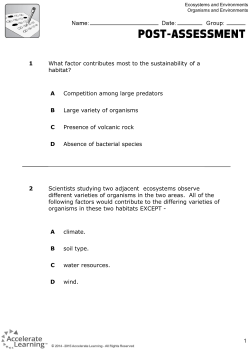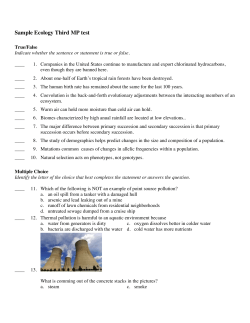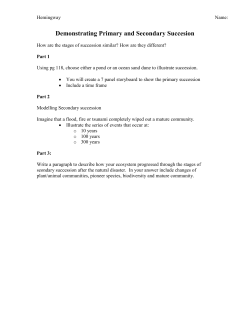
Chapter 4 â Ecosystems and Communities Chapter Mystery â The
BHS Biology – Chapter 4 – Ecosystems and Communities 1 BIG IDEA: INTERDEPENDENCE IN NATURE Essential Question: How do abiotic and biotic factors shape ecosystems? Chapter 4 – Ecosystems and Communities Chapter Mystery – The Wolf Effect During the 1930s, hunting and trapping eliminated wolves from Yellowstone National Park. For decades, ecologists hypothesized that the loss of wolves – important predators of Elk and other large grazing animals – had changed the park ecosystem. But because there were no before and after data, it was impossible to test the hypothesis directly. Then, in the mid-1990s, wolves were reintroduced to Yellowstone. Researchers watched park ecosystems carefully and sure enough, the number of elk in parts of the park began to fall just as predicted. But, unpredictably, forest and stream communities have changed, too. Could a “wolf effect” be affecting organisms in the park’s woods and streams? As you read this chapter, look for connections among Yellowstone’s organisms and their environment. Then solve the mystery. Climate 4.1 Guiding Question: What factors affect global climate? Section Omitted Niches and Community Interactions 4.2 Guiding Question: How do organisms interact with one another? 1. The Niche a. Tolerance = range of conditions an organism needs in order to survive (a pH or temperature you can keep fish in an aquarium) b. Habitat = the physical place where an organism lives c. Niche = what it does, what it needs, as well as the interactions the organism has with its surroundings and other organisms. BHS Biology – Chapter 4 – Ecosystems and Communities 2 BIG IDEA: INTERDEPENDENCE IN NATURE Essential Question: How do abiotic and biotic factors shape ecosystems? 2. Competition a. no two species can exist in the same niche, in the same habitat, at the same time. • one will be better adapted and the other will die out (outcompeted) – “competitive exclusion principle” b. similar species with similar niches will coexist by dividing resources and thereby changing niches 3. Predation, Herbivory, and Keystone Species a. Importance of PREDATOR-PREY relationships • Predators affect the size of prey populations • e.g. birds of prey controlling size of rodent populations b. Importance of HERBIVORE-PLANT relationships • Herbivores affect the size and distribution of plants (producers) • e.g. overabundance of deer causing eradication of food sources c. Keystone species - the single species that determines the health of the entire ecosystem. Altering numbers of this one species causes the downfall of the entire ecosystem • e.g. sea otters, sea urchins, kelp, seabirds 4. Symbioses a. Mutualism - both species benefit; sometimes becomes a dependence b. Parasitism - one benefits at the expense of the other c. Commensalism - one benefits, other is neither harmed nor helped 4.3 Succession Guiding Question: How do ecosystems change over time? 1. Ecological succession = series of relatively predictable changes in an ecosystem over time BHS Biology – Chapter 4 – Ecosystems and Communities 3 BIG IDEA: INTERDEPENDENCE IN NATURE Essential Question: How do abiotic and biotic factors shape ecosystems? 2. Primary and Secondary Succession a. Primary - succession where no life was found before • Pioneer species = first organisms to colonize barren areas b. Secondary - succession where life has previously existed • Faster than Primary c. Think of succession as nature’s means of making a habitat suitable for life d. Organisms have a way of causing a cascading reaction of succession • e.g. lichens create soil plants herbivores carnivores 3. The final outcome of succession (climax community) will not always be the same after succession in the same area 4.4 Biomes Guiding Question: What are the characteristics of the major biomes? 1. Terrestrial Biomes a. Tropical Rain Forest b. Tropical Dry Forest c. Tropical Grassland/Savannah d. Desert e. Temperate Grassland f. Temperate Woodland g. Temperate Forest h. Northwestern Coniferous i. Boreal Forest j. Tundra k. Mountain ranges l. Polar ice caps BHS Biology – Chapter 4 – Ecosystems and Communities 4 BIG IDEA: INTERDEPENDENCE IN NATURE Essential Question: How do abiotic and biotic factors shape ecosystems? 4.5 Aquatic Ecosystems Guiding Question: What are the characteristics of aquatic ecosystems? 1. Aquatic Ecosystems a. three levels - photic zone, aphotic zone, benthos b. stream (Freshwater) c. lake (Freshwater) d. Bog (Freshwater) e. Marsh (Freshwater) f. Swamp (Freshwater) g. Salt Marsh (Estuary) h. Mangrove Swamp (Estuary) i. Intertidal zone (Marine) j. Coastal Ocean (Marine) k. Open Ocean (Marine)
© Copyright 2025










